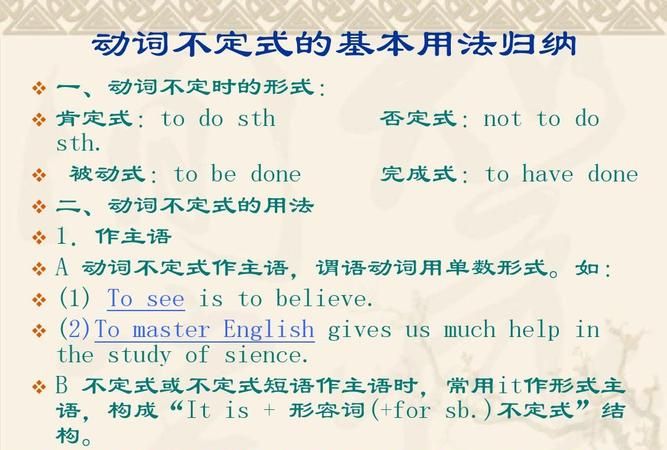本文目录
什么时候该用不定式,动名词,现在分词,过去分词
展开1全部
可以写成: Doing morning exercises is useful for our health 动词不定式用法总结 动词不定式在句中可充当主语、表语、宾语、宾补、定语和状语等。
一、作主语
动词不定式作主语可位于句首。例如:
To learn a skill is very important for everyone in society.
也可使用it作形式主语,而将其置于句末。例如:
It is necessary for young students to learn a foreign language.
动词不定式作主语的常用句型有:
1. It is+adj./ n. (+for sb./sth.) + to do sth.
用于此句型的形容词有:easy, hard, difficult, possible, important, impossible, necessary, good, bad, exciting, interesting, surprising等。例如:
It is interesting to play this game.
It is necessary for you to change your job.
It was impossible for them to complete the task in such a short time.
考例1:Is ____ possible to fly to the moon in a spaceship? (88 MET)
A. now B. man C. that D. it
用于此句型的名词有:pity, shame, pleasure, one’s duty, one’s job, fun, joy, good manners, bad manners等。例如:
What a pity it is for you to have missed such a wonderful film.
It is good manners for the young to give their seats to the old.
2. It is+adj.+of sb.+to do sth.
该句型中只能使用描述某人的品德、特征的形容词,如: kind, nice, wise, silly, polite, impolite, friendly, foolish, clever等。例如:
How rude it was of the boy to jump the queue!
It is friendly of the family to try to make me feel at home in their house.
How silly it was of you to give up such a good chance!
3. It takes sb.+some time+to do sth.
该句型意为“做某事花费某人多长时间”。例如:
It took us half an hour to ride to the town by bike.
二、作表语
动词不定式作表语常用于以下结构:My wish/ job/ aim/ goal is…及The next step/ measure is …等。例如:
Your job is to type the papers in the office.
The next measure is to stop the river from being polluted.
三、作宾语
常见的只能使用动词不定式作宾语的动词有:agree, choose, decide, hope, fail, wish, refuse, expect, manage, plan, intend, pretend, promise, offer, afford, demand, arrange等。 例如:They decided to build a highway between these two cities.
She offered to help me when I was in trouble.
believe, think, consider, feel, make等动词可用于“动词+ it +adj. / n+to do sth.”句型,其中使用it作形式宾语,而将真正的宾语动词不定式置于句末。例如:
I think it necessary for us to have a good rest after the long work.
She felt it her duty to help the old woman.
四、作宾补
可后接动词不定式作宾补的动词有:advise, allow, ask, hear, order, see, tell, want, wish, watch等。例如:
The doctor advised her no to eat too much sugar.
I wish you to go to the meeting with me.
believe, consider, count, declare, deny, feel, find, guess, imagine, judge, know, prove, realize, suppose, think等动词后可接to be型不定式作宾补。例如:
He declared himself to be a college student. 他自称是名大学生。
The police proved him to be a thief. 警察局证实他是小偷。
hope, demand, suggest等动词不能后接动词不定式作宾补。例如:
【误】I hope my son to be back soon.
【正】I hope my son will be back soon.
【误】She suggests us to have a discussion about it.
【正】She advises us to have a discussion about it.
【正】She suggests that we (should) have a discussion about it.
在主动结构中,下列动词后作宾补的动词不定式应省略to:“五看”(see, watch, notice, observe, look at)“三使”(make, let, have)“两听”(hear, listen to)“一感觉”(feel)。例如:
Who made him work all night long?
但是,改为被动结构后,应补出省略的to。例如:
He was seen to break the window.
五、作定语
动词不定式作定语,应位于所修饰词语之后,即:作后置定语。例如:
Have you got anything to eat? (to eat修饰anything,位于其后)
下列名词后常接动词不定式作定语:ability, attempt, chance, courage, decision, effort, failure, promise, way, wish等。例如:
But she gave up the chance to go abroad.
由only, first, last, next以及序数词或形容词最高级修饰的名词后,也常接不定式作定语。例如:
Who was the last one to leave the classroom last night?
六、作状语
动词不定式作状语,可表示目的、原因、结果或条件。例如:
We went there to see our grandparents.(目的)
I am very sorry to hear that.(原因)
She hurried home only to find her father dead.(结果)
To look at the picture, you would like it.(条件)
作目的状语,还可以使用in order to或so as to。例如:
The boy worked so hard in order to make up for the lost time.
结果状语还可以使用enough to, too…to…, so…as to, such… as to等结构。例如:
He got up too late to miss the early bus.
She was in such a hurry as not to notice me. 她如此匆忙,以致没有注意到我。

什么时候用动词不定式
展开1全部
动词不定式的用法
动词不定式(to do)是初中英语课本中的一个重点.
动词不定式是由“to+动词原形”构成 (有时可以不带to).其否定形式是“not+动词不定式”(not不与助动词连用).它属于一种非谓语动词的形式,在句子中不能充当谓语,没有人称和数的变化,但它可以保留动词的性质,其本身可以带宾语或状语等附加成分(不定式和其附加成分称为不定式短语).动词不定式(短语)的句法功能非常广泛,在句中可作主语、宾语、补足语、表语、定语及状语等成分.
一、作主语
(1)动词不定式作主语时,谓语动词常常用单数.例如:
To do morning exercises is useful for our health. 做早操有利于我们的健康.
To sweep the floor is my duty every day. 每天打扫地板是我的责任.
(2)如果动词不定式太长,常常用 it 作形式主语,而将真正的主语——动词不定式后置.例如:
It took me half an hour to walk there.我走到那儿花了半小时的时间.
It’s important for us to learn English well.对我们来说,学好英语是重要的.
二、作宾语
(1)能够接动词不定式作宾语的有 ask, agree, beg, decide, determine, fail, hope, manage, offer, plan, prepare, pretend, promise, refuse, wish 及 would like/love 等动词,但 finish, enjoy, miss, appreciate, mind, advise, suggest 等动词后面通常只能接动名词作宾语.例如:
I hope to visit this place again. 我希望能再度访问此地.
She enjoys reading very much.她非常喜欢读书.
The driver failed to see the other car in time. 司机没能及时看见另一辆车.
(2)动词不定式与名等词构成复合宾语时,通常要用 it 作形式宾语,而将真正的宾语——动词不定式后置.例如:
I think it our duty to obey the laws. 我认为遵守法律是我们的义务.
I found it difficult to see him here. 我发现在这里见到他是很难的.
三、作补足语
(1)某些动词在主动式中后接动词不定式作宾语补足语;在被动式中,由于原来的宾语变成了主语,故原来的宾语补足语变成了主语补足语.这类动词常用的有 consider, expect, tell, want, warn, wish,invite等.例如:
They told him not to be late again.他们告诉他不要再迟到了.→He was told not to be late again.
She invited me to have dinner with her yesterday.昨天她请我一起进餐.
(2)在feel(一感),listen to,hear(二听),let,make,have(三让),look at,see,watch,notice(四看)等词之后接不带to的不定式作宾语补足语,强调动作的完成过程;它们作被动句的谓语时,to要补上.如:
I heard her sing today.She sang wonderfully.今天我听见她唱歌了,她唱得非常精彩.
She was heard to sing today.今天有人听见她唱歌了.
She is often heard to sing this song(by us).我们经常听见她唱这首歌.
四、作状语
⑴动词不定式作状语可表示目的、原因及结果等,其逻辑主语就是句子的主语,因此动词不定式作状语往往用主动式.例如:
Come to see me again soon. 尽快再来看我.
I trembled to think of it. 我一想到那件事就不寒而栗.
You couldn't do that to save your life. 你即使为了救自己也不能那样做.
(2) only to do sth. 与 only doing sth. 都可作表示结果的状语,区别是:only to do sth. 表示一个与主语愿望相反的或出乎主语意料的结果, 或用来暗示最初的未能实现的动作;only doing sth. 表示谓语动词本身的动作造成的结果.例如:
I worked hard, only to fail at last. 我努力工作,结果最后却是失败.
He died, only leaving nothing but debts. 他死了,只留下一身债
五、作表语
(1)动词不定式往往放在系动词be(,become, sound, taste 等系动词后面一般不接不定式)的后面作表语,表示将来的情况,说明主语的内容.例如:
My wish is to become a teacher.我的愿望是当一名教师.
Your job today is to clean the playground. 你今天的工作是打扫操场.
(2)如果系动词后的动词说明主语的性质,特征,相当于形容词.这时就要用现在分词作表语,而不用不定式.例如:
He said that the story was interesting.他说这则故事很有趣.
六、作定语
(1)动词不定式常常放在名词或不定代词后面作后置定语,其逻辑主语往往是句子的主语,故动词不定式作定语时往往用主动式;如果动词不定式的逻辑主语不是句子的主语,该动词不定式要用被动式.例如:
Do you have anything to do tonight? 你今晚有什么事要做吗?
I am going to Shanghai tomorrow. Do you have anything to be taken there? 明天我要去上海.你有什么东西要捎去的吗?
(2)动词不定式作定语往往表示尚未发生的动作,如果动作已发生或正在发生,一般用现在分词作定语.例如:
I have no pen to write with.我没有钢笔写字.
The man standing there is Li Ming. 站在那里的那个人是李明.
七、和疑问词连用:
不定式前可用what,who,which,where,when,how,why等疑问词构成不定式短语,这种短语在句子中可作主语、宾语和表语等成分.
(1)作主语.例如:
When to start has not been decided. 什么时候出发还没定下来.
(2)作表语.例如:
The question is how to do the job well. 问题是怎样做好这项工作.
(3)作宾语.例如:
He told me where to find the book. 他告诉我了在哪找到这本书的.
Do you know how to play football? 你知道怎样踢足球吗?
八、不定式的被动式
在初中阶段还涉及到动词不定式被动式的一般式,这种形式是由“to be+动词过去分词”构成的,表示“被……”之意.例如:
There are twenty more trees to be planted. 有更多的树要栽种.

英语什么情况下会用到不定式
展开1全部
动词不定式概述
一 不定式的体
1. 不定式的一般式(to do)表示不定式的.动作将要发生或与谓语动作同时发生.
2 不定式的进行体(to be doing)表示不定式的动作正在发生.
不定式的完成体(to have done)表示不定式的动作在谓语动作之前发生.
二 不定式的逻辑主语
1 不定式的逻辑主语常不出现在句中.
2 句子的主语,宾语有时是不定式的逻辑主语.
3 不定式前"for+名词/代词"结构中的名词或代词也可以用来表示不定式的;逻辑主语.
4 在"It+be+形容词+of+名词/代词+to do"结构中,名词或代词为不定式的逻辑主语.该结构中的形容词通常用来表示人的品质.例如:kind, good, nice, bad, cruel, honest, bold, thoughtful, right, wrong, wise, clever, silly, foolish, careless, rude等.
例如:It's very kind of you to cal to tell me about the conference.
三 不定式的否定式
不定式否定式由not/never +to do构成
四 不定式的句法功能
1 不定式做主语
1)To say something is one thing; to do it is another.
2)It is not a good idea to build houses along the lines where two of the earth's plates join together.
注:充当主语的不定式即可置于句首,位于谓语动词之前,也可作为句子的真正主语置于句末,用作形式主语.
2 不定式作表语
3)Her uncle seems to be acting rather strangely towards her these days.
4)The purpose of the fence is to keep out a type of wild dog called a "Dingo".
5)One suggested answer is for farmers to limit the number of their cattle.
注:充当表语的不定式一般位于be ,seem等系动词后.
3 不定式作宾语
6)Shylock agreed to lend Antonio money on one condition.
注:充当宾语的不定式位于及物动词后.常用不定式作宾语的动词有:agree, plan, determine, dare, refuse, hope, wish, expect, promise, choose, pretend, decide, manage, intend, offer, afford, demand.
7)The dusty air makes it difficult to get a clear picture of space.
注:充当宾语的不定式如果有自己的表语,则可用代替只个不定式作为形式宾语,而作为真正宾语的不定式则放在表语之后.以it作为形式宾语的这种结构常用在think, feel, find, make, consider等动词之后.
big and strong.
4 不定式作宾语补足语
8)The powder made from fish, blood and bones will make the cabbage plants grow big and strong.
9)Portia told Bassanio to go to his friend at once.
注:在下列动词后作宾语补足语的不定式通常不带to.这些动词是observe, notice, see, hear, watch, have, feel, make, let.但上述动词转换为被动语态时,其后的不定式须带to.例如:The cabbage plants will be made to grow
动词不定式(todo)是初中英语课的一个重点,也是中考要考查的一个项目。动词不定式属于非谓语动词的一种形式,很多同学经常把它和谓语动词混在一起,掌握起来有困难。下面我们对动词不定式的用法做简单归纳,帮助同学们记忆:
一、动词不定式在句子中不能充当谓语,没有人称和数的变化。
二、动词不定式是由“to+动词原形”构成(有时可以不带to)。动词不定式的否定形式是“not+动词不定式”(not不与助动词连用)。
三、动词不定式短语具有名词、形容词和副词等的功能,可在句中用做多种句子成分。

语法填空什么时候用不定式
展开1全部
用法太多,这里写几种。
第一,用不定式表将来的目的性行为.
第二,用不定式修饰被序数词,最高级,no,any,all所限定的中心词.
第三,用不定式修饰抽象名词.(ability,chance,idea,excuse,promise,等等)

以上就是关于什么时候填不定式 ,什么时候该用不定式,动名词,现在分词,过去分词的全部内容,以及什么时候填不定式 的相关内容,希望能够帮到您。

